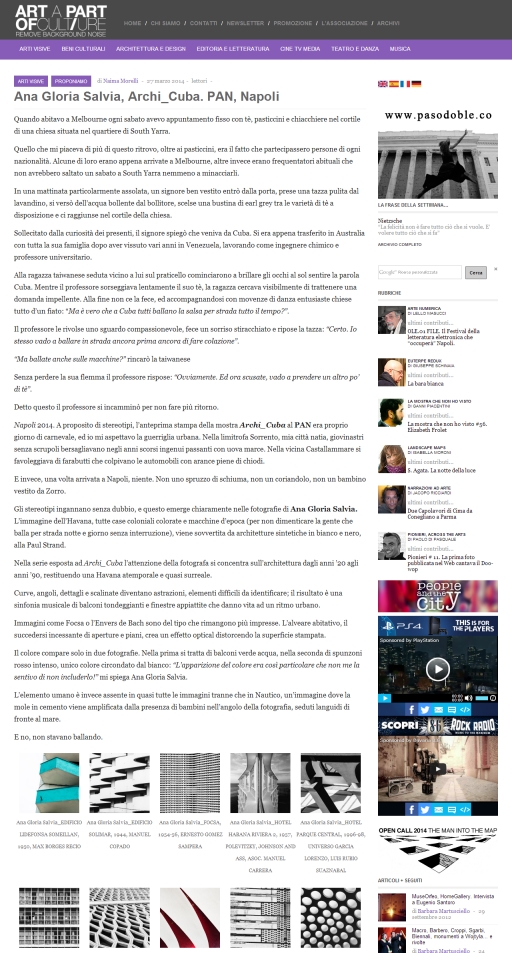
The Italian magazine Art a Part of Cult(ure) has just published my review of Ana Gloria Salvia’s exhibition “Archi_Cuba” at PAN, Naples
Read More
The Italian magazine Art a Part of Cult(ure) has just published my review of Ana Gloria Salvia’s exhibition “Archi_Cuba” at PAN, Naples
Read More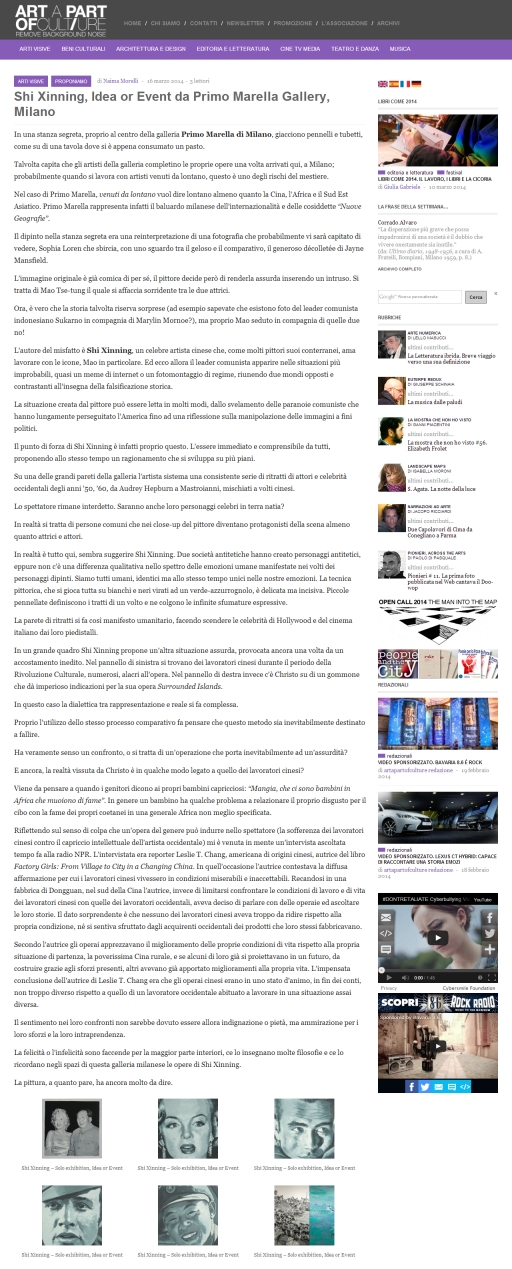
The Italian magazine Art a Part of Cult(ure) has just published my review of Shi Xinning’s exhibition “Idea or Event” at Primo Marella Gallery, Milan.
Read More
C’era insomma un tempo dove il garage non era più quel luogo dove parcheggiavi la macchina e stipavi il televisore rotto.
C’era un tempo dove tutto era spartano e vivido. Basico. Come dire, un garage, un gallerista e la centralità dell’arte.
Grossomodo è così che l’arte moderna in Italia si è incamminata verso la contemporaneità.
Erano tempi mitici, dove le gallerie venivano allagate o nelle quali passeggiavano cavalli.
L’unico problema a quei tempi, piuttosto marginale per l’arte contemporanea, era dove parcheggiare l’automobile.
Adesso probabilmente la gente prende meno multe per divieto di sosta, ma quell’atmosfera grunge e sincera sembra essere sparita. Diversamente da altre città europee, a Roma e a Milano le alternative alle immacolate stanze dell’arte contemporanea sono veramente poche.
“L’arte contemporanea italiana è diventata sempre più istituzionalizzata. Non c’è traccia delle esperienze d’avanguardia degli anni sessanta e settanta. Sono sorpreso in particolare dagli artisti più giovani. Sono infatti proprio loro i primi a cercare di entrare in un sistema dell’arte già bello e pronto, e nemmeno si sforzano di immaginare soluzioni alternative. La stessa pratica artistica sembra essere diventata una faccenda secondaria”, afferma l’artista Alessandro Cannistrà.
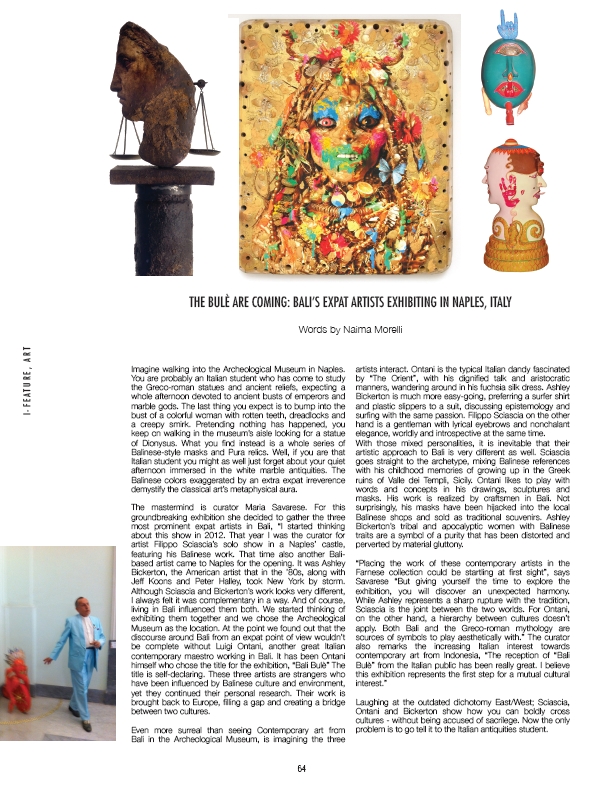
The Indonesian magazine I Magazine Bali has just published my review of the Bali Bulè exhibition at Museo Archeologico in Naples, featuring artists Bickerton, Ontani and Sciascia.
Here the link to the magazine website
Read More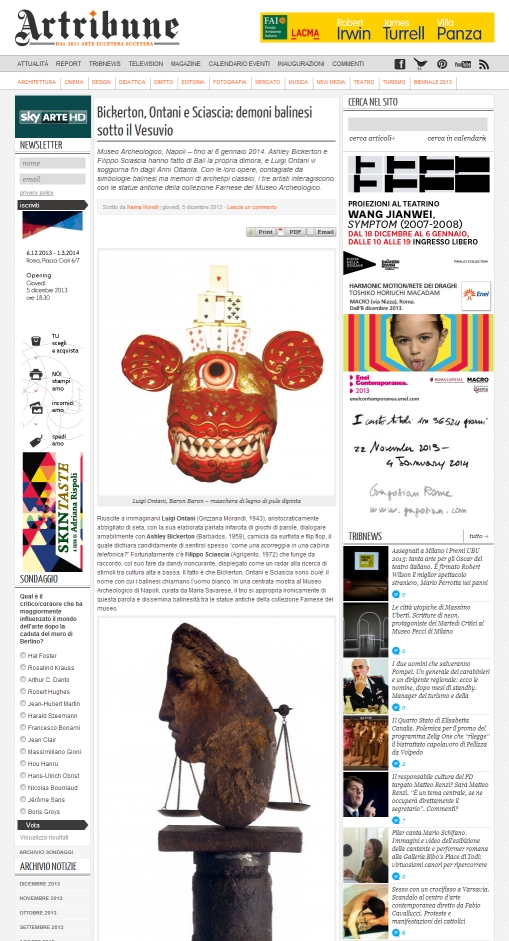
The Italian magazine Artribune has just published my review of the Bali Bulè exhibition at Museo Archeologico in Naples, featuring artists Bickerton, Ontani and Sciascia.
Read More
Since no one cares about the 55th Venice Biennale anymore, I feel like sharing my definitive thoughts about my favourite pavilion, without anyone there to contradict me.
So, chart lovers, my favourite pavilion was the Indonesian one, curated by Rifky Effendy.
In no other pavilion the installations of different artists work so perfectly together. The show almost looked like one single artist and yet it encapsulated such a richness of discourses.
If you were at the Venice Biennale in October, you would have seen me wandering in the Arsenal looking for the Indonesian Pavillion.
I actually overshot the main entrance, so I came in by the back door.
It was dark inside, and there was a soft music that I didn’t notice in the first place. The music though ended up being a background noise influencing the entire experience of the pavilion.
The soundscape was actually by Solo composer Rahayu Supanggah, the guy who reinvented traditional Indonesian music. For the Biennale’s composition he was inspired by the theme of the pavilion, which was “Sankti”.
As the press release stated, Sankti is a sanskrit word that refers to the primordial cosmic energy and the personification of the divine, feminine creative energy, as well as indicating change and liberation.
The first dark-metal work I encountered immediately struck me with his expressive power.
A group of man wearing a Muslim hat were sitting at a table. One man was laying with his head on the table, like someone who had been shot or something. One man was pointing his finger to another gentleman, who looked baffled. If you looked better at these two figures and you would notice that their legs where stretched under the table so to touch each other.
But the figure that really stood out was a matriarch in traditional clothes, upright at the end of the table. She was bringing a hand at his chest like saying: “Who, me?”
A weird lamp was falling from the ceiling, almost touching the table. It was shaped like something between an octopus and a tropical fruit.
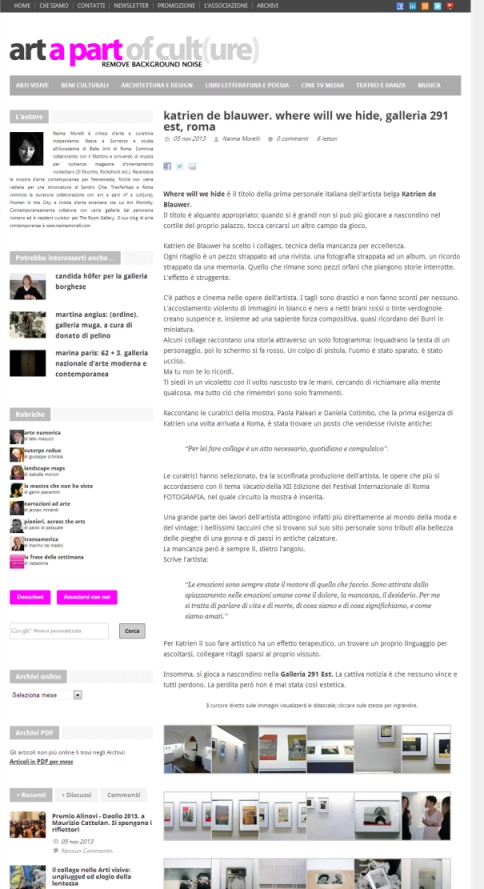
The Italian web magazine Art a Part of Cult(ure) has just published my review of the Katrien de Blauwer’s exhibition “Where will we hide” at Galleria 291 est, Rome.
Here you are the link to the review
Read More
“The Act of Killing” is the kind of movie that shuts you up for at least fifteen minutes after the credits. It makes you so uncomfortable that you can just chatter about irrelevant stuff with your friends out of the cinema.
Then, on the tram the way home, you suddenly burst in wordiness.
What happened is that “The Act of Killing” has finally been screened in Italian cinemas.
I went to see it the other day with a group of friends at the “Cinema Aquila”, in Pigneto, Rome.
The Act of Killing is an unconventional documentary film directed by Joshua Oppenheimer.
The film deals with the systematic slaughter of real or supposed communists in the aftermath of a failed coup in 1965 that led to General Suharto assuming power.
The director was not interested in gave a full picture of the historical events though. He didn’t even mention Suharto once.
The documentary revolves instead around the character of Anwar Congo, a leader of paramilitary organisation Pancasila Youth, whose job was to kill prisoners.
Because the historical picture was only hinted, I wouldn’t say it is a movie specifically about Indonesia’s ’65.
I would rather say it’s a movie about “the act of killing” itself, the psychology of the killer and the banality of evil.
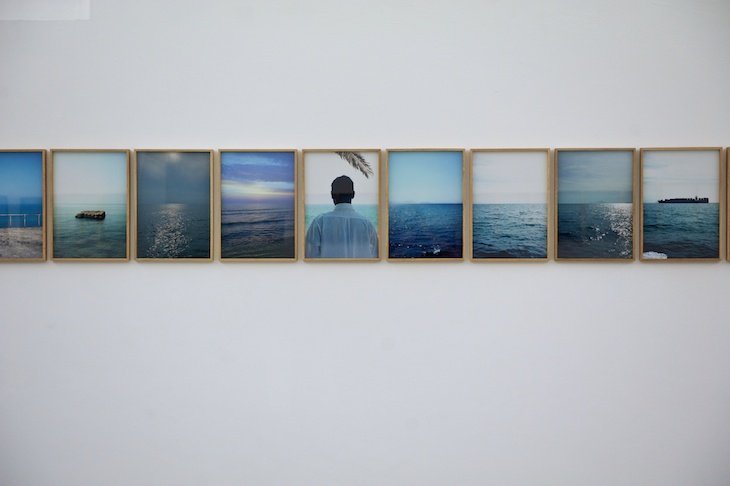
We have seen plenty of celebrations of the sea. The only subject that is as hackneyed as the sea is the sky. And love.
But really, to be innovative is not to talk about a new subject for the first time. To be innovative is to be able of talking about a corny subject in a new, or personal or moving way.
If you are a musician, go ask Ivano Fossati about it. If you are a painter, ask Piero Guccione. If you are a photographer, do what Monitor Gallery did. Go ask Antonio Rovaldi.